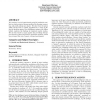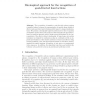53 search results - page 5 / 11 » Predicting Speech Intelligibility from a Population of Neuro... |
ICASSP
2008
IEEE
14 years 2 months ago
2008
IEEE
The reverberation time is one of the most prominent acoustic characteristics of an enclosure. Its value can be used to predict speech intelligibility, and is used by speech enhanc...
ATAL
2008
Springer
13 years 9 months ago
2008
Springer
We construct a novel agent-based model of prediction markets in which putative human qualities like learning, reasoning, and profit-seeking are absent. We show that the prices whi...
UM
2010
Springer
13 years 11 months ago
2010
Springer
Abstract. Recent progress has been made by using sensors with Intelligent Tutoring Systems in classrooms in order to predict the affective state of students users. If tutors are a...
CAIP
2009
Springer
14 years 2 months ago
2009
Springer
The recognition of transitive, goal-directed actions requires a sensible balance between the representation of specific shape details of effector and goal object and robustness w...
FLAIRS
2006
13 years 9 months ago
2006
We introduce a novel learning algorithm for noise elimination. Our algorithm is based on the re-measurement idea for the correction of erroneous observations and is able to discri...


